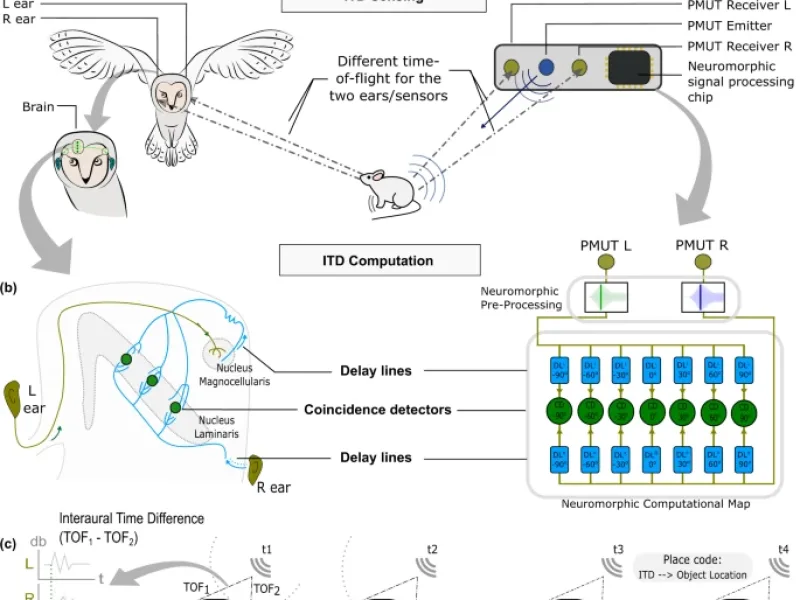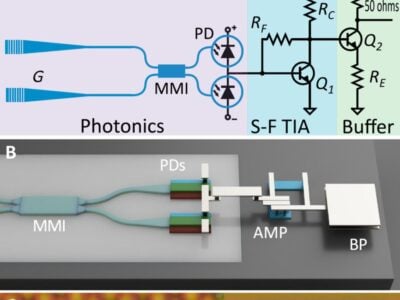
In-memory neuromorphic AI slashes power consumption to nW
CEA-Leti has developed an event-driven machine learning system that couples piezoelectric, ultrasound transducers to a spiking AI processor based on resistive memory for an ultra-low power sensor with a consumption of nanowatts.
The research team in France developed the auditory-processing system with energy efficiency five orders of magnitude compared to conventional localization systems.
“Real-world sensory-processing applications require compact, low-latency, and low-power computing systems,” says the paper in Nature Communications. “Enabled by their in-memory, event-driven computing abilities, hybrid memristive-complementary metal-oxide semiconductor (CMOS) neuromorphic architectures provide an ideal hardware substrate for such tasks.”
Related spiking AI articles
- ST hints at analog in-memory computing chip
- Opteran raises $12m for neuromorphic AI
- €3m project to boost neuromorphic AI
The design mimics biological signal processing with event-driven neuromorphic sensing and analog in-memory computing.
“We drew inspiration from biology to incorporate these two aspects of computation into our hardware, leveraging CEA-Leti’s state-of-the-art ultrasound sensors and resistive memory technologies,” said Elisa Vianello, senior scientist and Edge AI program coordinator, and senior author of the paper. “In particular, we focused on the acoustic-based, object-localization task. Owls efficiently solve this problem and thus we extrapolated their computational principles into our system.”
CEA-Leti built and tested this object localization system with the help of CEA-List, University of Zurich, University of Tours and University of Udine researchers. The team used CEA-Leti’s piezoelectric micromachined ultrasound transducer (pMUT) sensors and spiking neural networks based on resistive memory technologies.
The researchers’ first challenge was developing a pre-processing pipeline that extracts the key information from pMUTs, which encode information based on brief events or spikes. This temporal signal coding leads to higher energy-efficiencies compared to traditional continuous analogue or digital data, so that only relevant data are processed.
“Our system, which could have future use in sensor-fusion applications, mimics the owl’s extremely energy- efficient prey-capture mechanism, which is preceded by combined auditory and visual search,” said Filippo Moro, lead author of the paper. “The ultralow power consumption auditory search is always active and when a specific auditory neuron fires, the owl has the information it needs to start the visual search, which is more precise but more costly in terms of energy consumption.”
The second challenge was designing and fabricating an analog RRAM-based circuit to efficiently process the extracted events and estimate an object’s location. Resistive memory provides a compact solution to store the synaptic weights and RRAMs are non-volatile devices, a feature that matches the asynchronous event-driven nature of the team’s proposed system, resulting in no power consumption when the system is idle.
“To minimize the energy consumption of the object localization system, researchers envisioned, designed, and implemented an efficient RRAM-based neuromorphic circuit that processes signal information produced by embedded sensors to calculate a targeted object’s position in real time,” the paper reports. “Whereas conventional processing techniques would continuously sample the detected signal and crunch calculations to extract the useful information, the proposed neuromorphic solution computes asynchronously as the useful information arrives: this has allowed us to increase the system’s energy efficiency by up to five orders of magnitude.”
The design was compared to a microcontroller performing the same localization task using conventional beamforming or neuromorphic techniques.
The single bank power consumption for the neuromorphic pre-processing of the pMUT signal was 9.7 nW, with an energy per operation estimated by SPICE simulations at 21.6 nJ. The neuromorphic system is activated only at the arrival of an input event, i.e., when the sound wave reaches any of the pMUT receivers and overcomes the detection threshold, and kept idle otherwise. This allows avoiding unnecessary energy consumption when no input signal is present. Considering a rate of localization operations of 100 Hz and an activation period of 300 μs per operation, the power consumption of the neuromorphic computational map is 61.7 nW. Adding in the neuromorphic pre-processing applied to each of the pMUT receivers brings the total system’s power consumption to 81.6 nW.
This compares to a microcontroller beamforming signal processing design with five pMUT receivers with a power consumption of 11.71 mW.
Spiking neural networks have been a key focus for CEA-Leti over the past decade. The current work shows that combining visual sensors, such as DVS cameras, and the proposed pMUT-based audition sensor should be explored to develop future consumer robotics.
In March, Vianello received a €3 million grant from the European Research Council (ERC) to build nanoscale memory devices inspired by insect nervous systems for such applications as consumer robotics, implantable medical diagnostic microchips and wearable electronics. Opteran in London has also raised $12m to develop similar systems.
Related articles
- NASA looks to BrainChip’s spiking neural network chip for space
- Eta raises funds for spiking neural networks
- Intel launches second generation neuromorphic chip on 4nm
Other articles on eeNews Europe
- Infineon teams for commercial ion trap quantum processors
- Newport chip foundry still possible says Nexperia
- First native RISC-V laptop readies for market
- II-VI renames as Coherent deal completes
- Algorithms agreed for post-quantum security standard
 If you enjoyed this article, you will like the following ones: don't miss them by subscribing to :
eeNews on Google News
If you enjoyed this article, you will like the following ones: don't miss them by subscribing to :
eeNews on Google News




